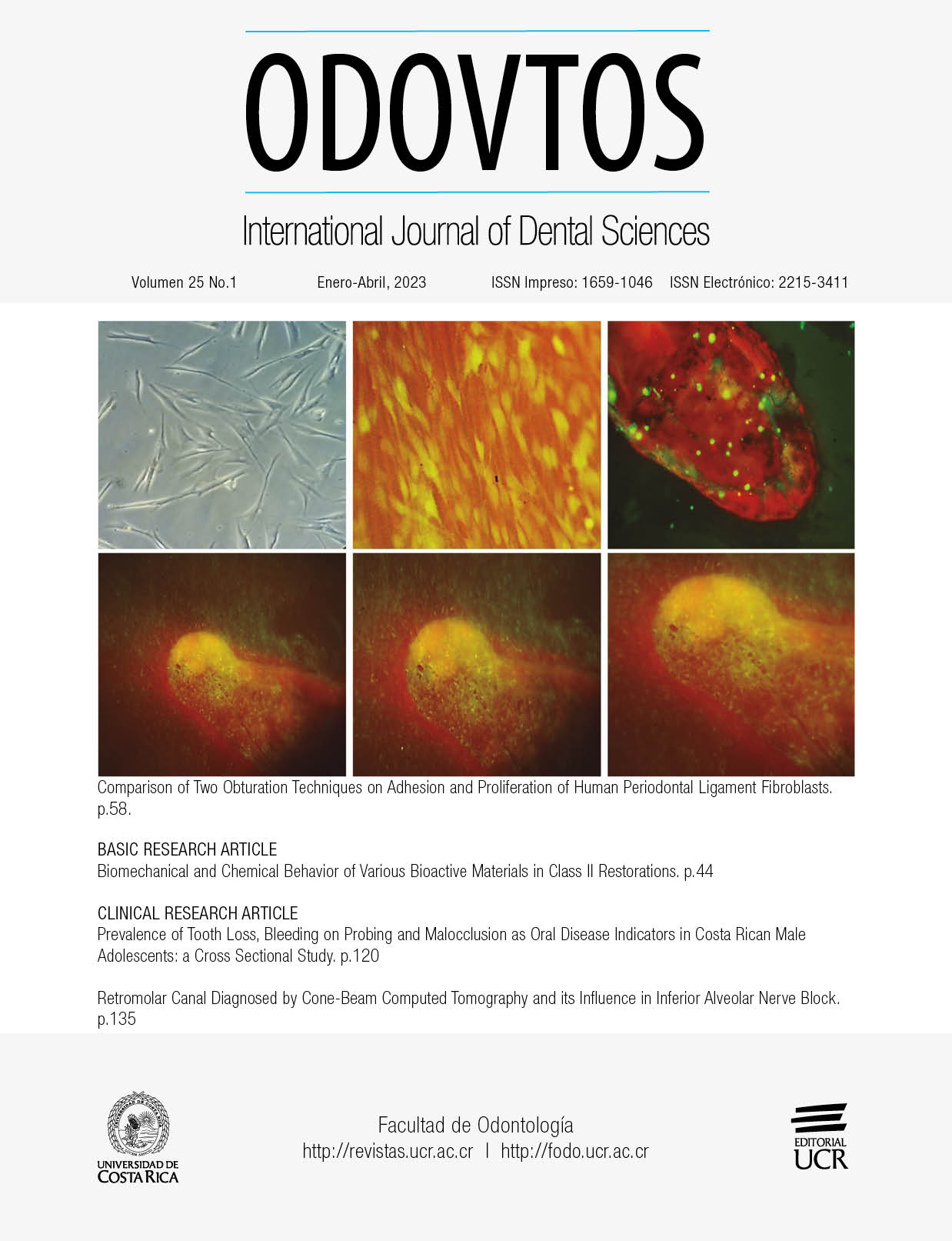Resumen
El propósito de esta investigación fue la evaluación tomográfica de la placa ósea mandibular (POM) en pacientes de ortodoncia con diferente patrón de crecimiento vertical. Se realizó un estudio de tipo observacional, descriptivo, transversal y retrospectivo. Se observó imágenes tomográficas de pacientes de 14 a 40 años de edad y se formó una base de datos con las que cumplían los criterios de selección. El tamaño de muestra fue de 10 para cada grupo según patrón de crecimiento vertical (hipodivergentes, normodivergentes e hiperdivergentes). Luego se seleccionaron cuatro zonas de inserción frecuente de minitornillos extralveolares en la POM, tomando como referencia las raíces mesial y distal del primer y segundo molar mandibular. Al realizar la comparación de las características de la POM entre patrones de crecimiento vertical, entre sexos y hemiarcadas no se encontraron diferencias estadísticamente significativas. Sin embargo, cuando se comparó las características de la POM según la raíz de referencia se encontró que había diferencias estadísticamente significativas. La zona vestibular a la raíz distal de la segunda molar mandibular presento los mayores valores en cuanto angulación, altura y grosor. No existen diferencias significativas en las características óseas de la POM según patrones de crecimiento vertical, sexos o hemiarcadas. La angulación, la altura y el grosor aumenta progresivamente desde el hueso vestibular de la raíz mesial del primer molar mandibular hacia la raíz distal del segundo molar.
Citas
Chang C., Huang C., Roberts W.E. 3D Cortical bone anatomy of the mandibular buccal shelf: a CBCT study to define sites for extra-alveolar bone screws to treat class III malocclusion. Int J Orthod Implan. 2016; 41:.74-82.
Jing Y., Han X., Guo Y., Li J., Bai D. Nonsurgical correction of a Class III malocclusion in an adult by miniscrew-assisted mandibular dentition distalization. Am J Orthod Dentofacial Orthop 2013; 143: 877-87.
Ramírez-Ossa D.M., Escobar-Correa N., Ramírez-Bustamante M.A., Agudelo-Suárez A.A. An umbrella review of the effectiveness of temporary anchorage devices and the factors that contribute to their success or failure. J Evid Based Dent Pract 2020; 20: 101402.
Marquezan M., Mattos C.T., Sant’Anna E.F., de Souza M.M., Maia L.C. Does cortical thickness influence the primary stability of miniscrews?: A systematic review and meta-analysis. Angle Orthod 2014; 84 (6): 1093-103.
Chen K., Cao Y. Class III malocclusion treated with distalization of the mandibular dentition with miniscrew anchorage: A 2-year follow-up. Am J Orthod Dentofacial Orthop. 2015; 148 (6): 1043-53.
Chang C., Liu S.S.Y., Roberts W.E. Primary failure rate for 1680 extra-alveolar mandibular buccal shelf mini-screws placed in movable mucosa or attached gingiva. Angle Orthod. 2015; 85 (6): 905-910.
Nucera R., Lo Giudice A., Bellocchio A.M., Spinuzza P., Caprioglio A., Perillo L., et al. Bone and cortical bone thickness of mandibular buccal shelf for mini-screw insertion in adults. Angle Orthod 2017; 87: 745-51.
Migliorati M., Benedicenti S., Signori A., Drago S., Barberis F., Tournier H., et al. Miniscrew design and bone characteristics: an experimental study of primary stability. Am J Orthod Dentofacial Orthop 2012; 142: 228-34.
Elshebiny T., Palomo J.M., Baumgaertel S. Anatomic assessment of the mandibular buccal shelf for miniscrew insertion in white patients. Am J Orthod Dentocial Orthop. 2018; 153 (4): 505-11.
Kapila S.D., Nervina J.M. CBCT in orthodontics: assessment of treatment outcomes and indications for its use. Dentomaxillofac Radiol. 2015; 44 (1): 20140282.
De Grauwe A., Ayaz I., Shujaat S., Dimitrov S., Gbadegbegnon L., Vande Vannet B., Jacobs R. CBCT in orthodontics: a systematic review on justification of CBCT in a paediatric population prior to orthodontic treatment. Eur J Orthod. 2019; 41 (4): 381-389.
Abdelkarim A. Cone-Beam Computed Tomography in Orthodontics. Dent. J. 2019; 7 (3): 89.
Sadek M.M., Sabet N.E., Hassan I.T. Three-dimensional mapping of cortical bone thickness in subjects with different vertical facial dimensions. Prog Orthod. 2016; 17 (1): 32.
Escobar-Correa N., Ramírez-Bustamante M.A., Sánchez-Uribe L.A., Upegui-Zea J.C., Vergara-Villarreal P., Ramírez-Ossa D.M. Evaluation of mandibular buccal shelf characteristics in the Colombian population: A cone-beam computed tomography study. Korean J Orthod. 2021 Jan 25; 51 (1): 23-31.
Aleluia R.B., Duplat C.B., Crusoé-Rebello I., Neves F.S. Assessment of the mandibular buccal shelf for orthodontic anchorage: Influence of side, gender and skeletal patterns. Orthod Craniofac Res. 2021; 24 Suppl 1: 83-91.
Rickets R.M., Roth R.H., Chaconnas S.J., Schulhof R.J., Engle G.A. Orthodontic diagnosis and planning. Denver: Rocky Mountain Data System; 1982.
Gregoret J., Tuber E., Escobar H., Matos-Da Fonseca A. Ortodoncia y cirugía ortognática, diagnostico y planificación. 2da edición. España: Editorial Publicaciones Médicas Barcelona; 1997.
Siriwat P.P., Jarabak J.R. Malocclusion and facial morphology is there a relationship? An epidemiologic study. Angle Orthod. 1985 Apr; 55 (2): 127-38.
García-Lallana A., Viteri-Ramírez G., Saiz-Mendiguren R., Broncano J., Dámaso J. Ergonomía del puesto de trabajo en radiología. Radiología. 2011; 53 (6): 507-15.
Echeverri S., Giraldo D., Lozano L., Mejía P.A.; Montoya L., Vásquez E.M. Síndrome de visión por computador: una revisión de sus causas y del potencial de prevención. Rev CES Salud Pública. 2012; 3 (2): 193-201.
Trivedi K., Jani B.K., Hirani S., Radia M.V. Comparative Evaluation of Cortical Bone Anatomy of Mandibular Buccal Shelf for Mini Implant Placement in Different Facial Divergence: A Cone Beam Computed Tomography Study. J Indian Orthod Soc. 2020; 54 (4): 325-331.
Gandhi V., Upadhyay M., Tadinada A., Yadav S. Variability associated with mandibular buccal shelf area width and height in subjects with different growth pattern, sex, and growth status. Am J Orthod Dentofacial Orthop. 2021 Jan; 159 (1): 59-70.
Parinyachaiphun S., Petdachai S., Chuenchompoonut V. Considerations for placement of mandibular buccal shelf orthodontic anchoring screw in Class III hyperdivergent and normodivergent subjects-A cone beam computed tomography study, Orthod Waves. 2018; 77 (1): 44-56.
Farnsworth D., Rossouw P.E., Ceen R.F., Buschang P.H. Cortical bone thickness at common miniscrew implant placement sites. Am J Orthod Dentofacial Orthop. 2011; 139: 495-503.
Kolge N.E., Patni V.J., Potnis S.S. Tomographic mapping of Buccal Shelf area for optimum placement of bone screws: A three-dimensional cone-beam computed tomography evaluation. APOS Trends Orthod 2019; 9 (4): 241-5.
##plugins.facebook.comentarios##

Esta obra está bajo una licencia internacional Creative Commons Atribución-NoComercial-CompartirIgual 4.0.
Derechos de autor 2022 CC-BY-NC-SA 4.0


